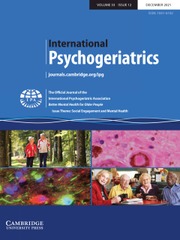Crossref Citations
This article has been cited by the following publications. This list is generated based on data provided by
Crossref.
Lara, Lúcia Alves da Silva
Scalco, Sandra Cristina Poerner
Troncon, Júlia Kefalás
and
Lopes, Gerson Pereira
2017.
A Model for the Management of Female Sexual Dysfunctions.
Revista Brasileira de Ginecologia e Obstetrícia / RBGO Gynecology and Obstetrics,
Vol. 39,
Issue. 04,
p.
184.
dos Santos Gomes, Cristiano
Pirkle, Catherine McLean
Zunzunegui, Maria Vitoria
Taurino Guedes, Dimitri
Fernandes De Souza Barbosa, Juliana
Hwang, Phoebe
and
Oliveira Guerra, Ricardo
2018.
Frailty and life course violence: The international mobility in aging study.
Archives of Gerontology and Geriatrics,
Vol. 76,
Issue. ,
p.
26.
Sigurdardottir, Sigrun
and
Halldorsdottir, Sigridur
2018.
Screaming Body and Silent Healthcare Providers: A Case Study with a Childhood Sexual Abuse Survivor.
International Journal of Environmental Research and Public Health,
Vol. 15,
Issue. 1,
p.
94.
Hamdullahpur, Kevin
Jacobs, Kahá:wi J.
and
Gill, Kathryn J.
2018.
Mental Health Among Help-Seeking Urban Women: The Relationships Between Adverse Childhood Experiences, Sexual Abuse, and Suicidality.
Violence Against Women,
Vol. 24,
Issue. 16,
p.
1967.
Flores, Renee J.
Campo-Arias, Adalberto
Stimpson, Jim P.
Chalela, Claudia M.
and
Reyes-Ortiz, Carlos A.
2018.
The Association Between Past Sexual Abuse and Depression in Older Adults From Colombia.
Journal of Geriatric Psychiatry and Neurology,
Vol. 31,
Issue. 1,
p.
13.
Reyes‐Ortiz, Carlos A.
Ocampo‐Chaparro, Jose Mauricio
Campo‐Arias, Adalberto
Holmes, Holly
and
Halphen, John
2018.
Association Between History of Abuse and Falling in Older Adults.
Journal of the American Geriatrics Society,
Vol. 66,
Issue. 8,
p.
1603.
Russell, Kristan N.
and
Marsh, Shawn C.
2018.
When Juveniles Commit Sexual Offenses: Considerations and Recommendations for Judges.
Juvenile and Family Court Journal,
Vol. 69,
Issue. 2,
p.
37.
Lee, Hsing-Feng
Liu, Pei-Yi
Wang, Yen-Po
Tsai, Chia-Fen
Chang, Full-Young
and
Lu, Ching-Liang
2018.
Sexual Abuse Is Associated With an Abnormal Psychological Profile and Sleep Difficulty in Patients With Irritable Bowel Syndrome in Taiwan.
Journal of Neurogastroenterology and Motility,
Vol. 24,
Issue. 1,
p.
79.
Badley, Elizabeth M.
Shields, Margot
O'Donnell, Siobhan
Hovdestad, Wendy E.
and
Tonmyr, Lil
2019.
Childhood Maltreatment as a Risk Factor for Arthritis: Findings From a Population‐Based Survey of Canadian Adults.
Arthritis Care & Research,
Vol. 71,
Issue. 10,
p.
1366.
Henchoz, Yves
Seematter-Bagnoud, Laurence
Nanchen, David
Büla, Christophe
von Gunten, Armin
Démonet, Jean-Francois
and
Santos-Eggimann, Brigitte
2019.
Childhood adversity: A gateway to multimorbidity in older age?.
Archives of Gerontology and Geriatrics,
Vol. 80,
Issue. ,
p.
31.
Cameranesi, Margherita
Lix, Lisa M.
and
Piotrowski, Caroline C.
2019.
Linking a History of Childhood Abuse to Adult Health among Canadians: A Structural Equation Modelling Analysis.
International Journal of Environmental Research and Public Health,
Vol. 16,
Issue. 11,
p.
1942.
Kraav, Siiri-Liisi
Tolmunen, Tommi
Kärkkäinen, Olli
Ruusunen, Anu
Viinamäki, Heimo
Mäntyselkä, Pekka
Koivumaa-Honkanen, Heli
Valkonen-Korhonen, Minna
Honkalampi, Kirsi
Herzig, Karl-Heinz
and
Lehto, Soili M.
2019.
Decreased serum total cholesterol is associated with a history of childhood physical violence in depressed outpatients.
Psychiatry Research,
Vol. 272,
Issue. ,
p.
326.
Donoghue, Orna A.
McGarrigle, Christine A.
and
Kenny, Rose Anne
2019.
Encyclopedia of Gerontology and Population Aging.
p.
1.
Rapsey, Charlene M.
Scott, Kate M.
and
Patterson, Tess
2019.
Childhood sexual abuse, poly-victimization and internalizing disorders across adulthood and older age: Findings from a 25-year longitudinal study.
Journal of Affective Disorders,
Vol. 244,
Issue. ,
p.
171.
Maunder, Robert G.
Hunter, Jonathan J.
Tannenbaum, David W.
Le, Thao Lan
and
Lay, Christine
2020.
Physicians’ knowledge and practices regarding screening adult patients for adverse childhood experiences: a survey.
BMC Health Services Research,
Vol. 20,
Issue. 1,
Træen, Bente
Kvalem, Ingela Lundin
and
Ohnstad, Ingrid
2020.
Experiences of Non-consensual Sex of Older Adult Men and Women in Norway, Denmark, Belgium and Portugal.
Sexuality & Culture,
Vol. 24,
Issue. 1,
p.
113.
Paniagua, Nancy
Girón, Rocío
Goicoechea, Carlos
Martín‐Fontelles, Mª Isabel
and
Bagues, Ana
2020.
Maternal separation affects the electrophysiological properties of Aδ‐fibres and nociceptive behaviours in male and female mice.
International Journal of Developmental Neuroscience,
Vol. 80,
Issue. 6,
p.
538.
Lalchandani, Pooja
Lisha, Nadra
Gibson, Carolyn
and
Huang, Alison J.
2020.
Early Life Sexual Trauma and Later Life Genitourinary Dysfunction and Functional Disability in Women.
Journal of General Internal Medicine,
Vol. 35,
Issue. 11,
p.
3210.
Geraets, Anouk F.J.
and
van der Velden, Peter G.
2020.
Low-cost non-professional interventions for victims of sexual violence: A systematic review.
Aggression and Violent Behavior,
Vol. 53,
Issue. ,
p.
101425.
Määttä, Jaakko
Martikainen, Antti
Ikäheimo, Tiina-Mari
Nissen, Mette
Viinamäki, Heimo
von und zu Fraunberg, Mikael
and
Huttunen, Jukka
2020.
Benzodiazepine Use Is Associated With Poorer Spinal Cord Stimulation Outcome in 373 Neuropathic Pain Patients.
Neuromodulation: Technology at the Neural Interface,
Vol. 23,
Issue. 5,
p.
646.


